

We live in a world where businesses introduce new products every day. However, not all of them manage to survive. Only a small percentage of them succeed in making their place in our oversaturated market.
Therefore, the question is: What sets successful products apart? One of the leading causes of their success is the meticulous product discovery phase. This is when the idea of a new product is conceived through extensive market research, a deep understanding of user needs, and rigorous user testing.
This article will explore the product development stage, including its importance, steps, benefits, challenges, and critical elements.
What is Product Discovery?
Product discovery is the process of researching the needs and challenges of the users, ideating a solution, and developing a prototype for testing. The process results in the development of a usable and feasible product.
It involves carefully listening to user needs instead of creating a product that may or may not be successful. Therefore, product discovery is a highly customer-centric process. Customers are the ones who approve or deny the product prototype based on their feedback.
However, this process doesn’t end at idea conception. Instead, it continues throughout the development cycle as you continuously interact with customers and implement their feedback into development.
Understanding the Importance of Product Discovery
Product discovery is an essential step of the product development process. It allows you to form a deep understanding of your users as they guide you throughout your design process. Once you understand their challenges, you can look for the most viable solutions and use product design tools to develop prototypes.
This also increases your chances of designing a successful product, reducing the risks surrounding product development. Here are some other reasons why product discovery is crucial:
Understanding user needs
It lets you gain deep insights into your target user segments’ needs, preferences, and pain points. This is essential to creating products that resonate with your users and meet their requirements.
Market validation
Product discovery allows you to validate your ideas and concepts before investing significant resources in development and product delivery. You can mitigate the risk of creating a product that might not find a market or solve a real problem.
Innovation

A thorough product discovery process enables your teams to explore new ideas and solutions. You can hold brainstorming sessions with your team and use tools like ClickUp Whiteboard for easy cross-functional collaboration. You can also differentiate yourself from competitors by offering unique features and addressing customer needs in new ways.
Aligning with business goals
Another benefit of product discovery efforts is ensuring that the product aligns with the overall business strategy early on. It also helps your product and development teams prioritize product features essential for success.
A Step-by-Step Product Discovery Process
Now that you know the importance of product discovery, let us move on to steps to help you achieve a successful product discovery process.
Create a team
Product discovery is all about cross-functional collaboration. However, it is still critical to select the people who will participate in it, whether permanently or temporarily.
One thing to understand about creating a team is that there are no one-size-fits-all criteria. Therefore, your members will depend on your challenges and requirements. They can also change throughout the process as your needs and challenges change.
You may temporarily bring in an expert or involve the sales team to better understand the market and viability. Typically, a product discovery team consists of the following:
- Product manager: Oversees the entire process and ensures alignment with business goals
- UX/UI designers: Design the user experience and interface, translating insights from research into visually appealing designs
- Developers/Engineers: Implement technical aspects and feasibility, contributing insights on what is achievable within given constraints
- Market researchers: Conduct in-depth market analysis to identify trends, competitors, and potential opportunities
- Customer support: Bring direct user insights, feedback, and pain points into the process
Besides people, decide on the software you will use throughout the journey, like product management software or product development templates.
The benefits of having cross-functional teams include the following:
- Unique and diverse perspective: These teams foster a range of perspectives and approaches as individuals with different skills, backgrounds, and expertise participate in the process
- Faster decision-making: Decision-making is faster as representatives from various departments collaborate. This reduces the need for prolonged communication channels
- Problem-solving: The combination of diverse skills and experiences enables the team to approach challenges from various angles, enhancing problem-solving
- Less confirmation bias: It also reduces the chances of confirmation bias
Understand the underlying user needs
You have assembled your team, and the product management tools are also prepared. It is finally time to begin understanding the underlying customer needs. To do this, you need to communicate with your users.
Communication can take any form. Conduct customer interviews or hold surveys. You can also create journey maps. The goal is to collect a decent amount of information about their pain points and challenges.
- Customer feedback surveys: Use different surveys like in-app surveys, email surveys, passive feedback forms, or feature request widgets
- Interviews: Collect qualitative feedback from your target user segments by conducting interviews
- Product analytics: Check product analytics to gain insights into user behavior and identify pain points. You can also use your brand management software for better insights
- Focus groups: Assemble a small group of users for a focused discussion
- Social media monitoring: Monitor social media channels for mentions of your products or industry. Engage with users, address concerns, and gather feedback
Use various AI tools to improve the efficiency of the process. Once you’ve collected enough information, it is time to define the exact needs you will address. Here are the things to keep in mind while defining the need:
- Aim to express the problem concisely (in a short, simple sentence). This will allow you to communicate it with your team easily and develop your solution
- Validate the problem by checking whether it is significantly affecting your users
- Prioritize and decide which problem you will solve first
Identify and ideate the solution
With a clear problem, you can now focus on the solution part. Encourage your team to brainstorm and devise creative ways of solving the problem. Use these ideation techniques:
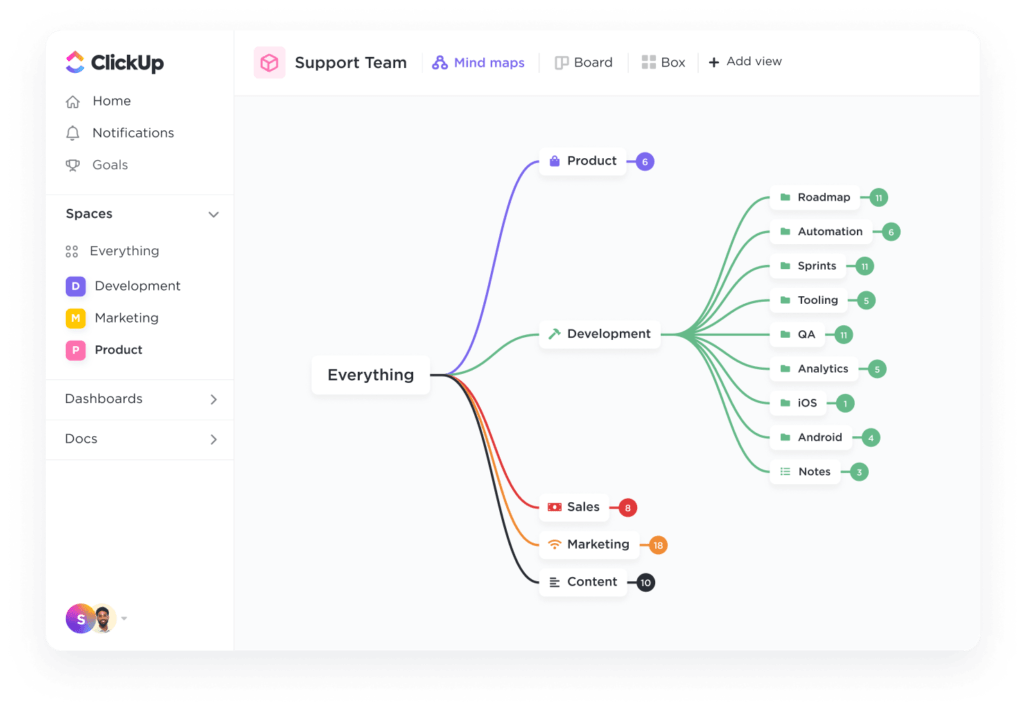
- Mind mapping: Use mind maps to write down and link your ideas for better ideation
- Storyboarding: Create a visual narrative around your problems to come up with viable ideas
- Round robin: Convert your problem into a question, starting with “How might we…” and let all team members propose a solution
- Sketching: Use the power of visuals to enhance your perspective and draw engaging sketches that communicate your message
- Brainwriting: Ask one of your team members to write down their idea and give it to the next person to add their thoughts. Continue until everyone has added something
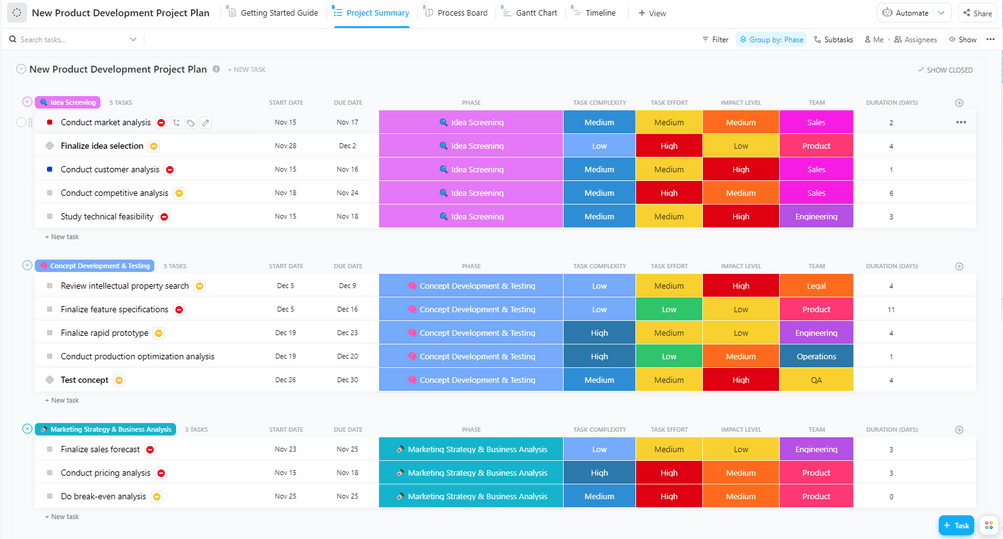
Feel free to use any method that works for your team, including product development templates, to design ideas.
Once you’ve filled your idea bank, you’ve to filter them by checking their potential impact and feasibility. This will help you prioritize the ideas that can be developed into prototypes and tested.
Here are the things to check while filtering ideas:
- Are they in line with the product vision and business goals?
- Is the idea relevant to your target users’ needs?
- Do your stakeholders or customers request something similar?
- Is your team passionate about it?
You can also use frameworks like the RICE, dot-voting, or Kano models to prioritize the opportunities better.
Develop prototype
At this stage, you are ready to develop a prototype. Prototypes are interactive visual representations of a product’s key features and functionalities. There are many types of prototypes, including mockups, minimum viable products, or sketches.
- Wireframe: Basic, digital representations of a product’s interface that emphasize structure and navigation
- Virtual Reality (VR)/Augmented Reality (AR): Prototypes for virtual reality environments or augmented reality devices
- Clickable Prototypes: These allow you to click through the interface, simulating interactions without the need for full functionality
- Minimum Viable Product (MVP): Functional versions of a product that include the minimum features to satisfy early adopters and deliver value to users
Select the right type of prototype and product delivery method for your team by considering your testing needs and improvement areas. Some benefits of developing prototypes include:
- Mitigates the risk of investing resources in a concept that may not resonate with users
- Allows you to identify potential issues early in the product development process
- Gather user feedback on design, usability, and the overall user experience
- Enables product teams to refine and improve the product based on continuous feedback
The process of developing a prototype is accompanied by regular testing.
Test the prototype
Testing the prototype helps you validate your solutions and check whether they can solve your customers’ problems. In this step, you have to collect user feedback carefully. Based on this, you can make changes and improvements until you’re fully satisfied.
Start testing simple prototypes like wireframes and use the feedback to develop higher-fidelity prototypes. Then, proceed to build a minimum viable product and test it.
Common methods of testing prototypes include:
- A/B testing: Present different versions of the prototype to various groups of participants to measure and compare their performance and preferences
- Customer interviews: Conduct one-on-one interviews with participants to gather in-depth qualitative customer feedback on their perceptions, preferences, and challenges with the prototype
- Fake door testing: Present a simulated product to users and check their interest and interaction
- Usability testing: Participants interact with the prototype while the facilitator observes and gathers user feedback on the overall user experience, ease of use, and navigation
- Surveys: Distribute surveys or questionnaires to a larger group of participants to gather quantitative data on specific aspects of the prototype
Selecting the right test depends on your audience and the type of information you want to gather.
The Benefits and Challenges of Product Discovery
Benefits
There are many benefits to the entire product discovery process. Let’s look at them.
Saving time and money
While discovery may look like a waste of time (as it doesn’t involve actively building something), it saves time and money. Wondering how? Product discovery validates your ideas and allows you to build a product with confidence that it will be successful. If you skip this stage, you’re essentially gambling with your money and time to develop a product your users may or may not use.
Innovative products
With a cross-functional team comes the ability to develop more innovative products. All your team members have their skills, experiences, and perspectives, which enable them to come up with different ideas and solutions.
User-centric designs
Your product discovery efforts allow you to conduct in-depth market research and understand customer needs. You develop more user-centric designs as you learn their pain points and challenges.
Risk mitigation
Product discovery also enables you to validate your ideas early. This helps mitigate the risk of investing time and resources in a product or feature that may not meet user needs or market demands.
Challenges
As with any process, product discovery also has a fair share of challenges, as listed below.
Forming a cross-functional product team
Forming a successful cross-functional product team is often challenging. The team members have different backgrounds and cultures and may have varying goals and priorities. Additionally, allocating resources across various functional areas can take time and effort.
Removing biases
One of the most common challenges during product discovery is confirmation bias. This bias negatively affects the results. Therefore, a product team must recognize and mitigate their biases immediately. This will help create a product with a higher chance of success.
Time constraints
Product discovery is the first step in product development. There is no time limit to it. Depending on your target market, scope, and many other factors, it may take only a few weeks or even several months. However, there may be pressure to move quickly, potentially leading to overlooking valuable insights.
Key Elements and Techniques in Conducting Product Discovery
Key elements of product discovery
A successful product discovery must have the following key elements:
- Clear problem definition: Clearly define the problem or pain point the product aims to solve. A well-defined problem provides focus and ensures that the product addresses a real user need
- User research: Understand the target audience through user research. Collect data on user behaviors, preferences, and pain points to inform the product’s design and features
- Cross-functional product teams: Form a cross-functional product team with diverse skills, including design, development, marketing, and customer support. This ensures a holistic approach and brings different perspectives to the discovery process
- Ideation: Conduct ideation sessions to generate a wide range of ideas. Encourage creativity and collaboration within the team, and use product management templates and tools to explore different solutions to the defined problem.
- Prototyping: Develop prototypes to visualize and test product concepts. Prototypes help gather early user feedback, identify potential issues, and refine ideas before full development
Techniques for conducting product discovery
ClickUp: An all-in-one product management tool
A successful product discovery is the combined result of human efforts and technology. ClickUp is an all-in-one product management tool that simplifies product management by managing your vision, aligning your team, and offering tools for collaboration.
ClickUp’s product offerings have a little something for all phases of product discovery. Let’s take a look.
ClickUp Whiteboard and AI for brainstorming
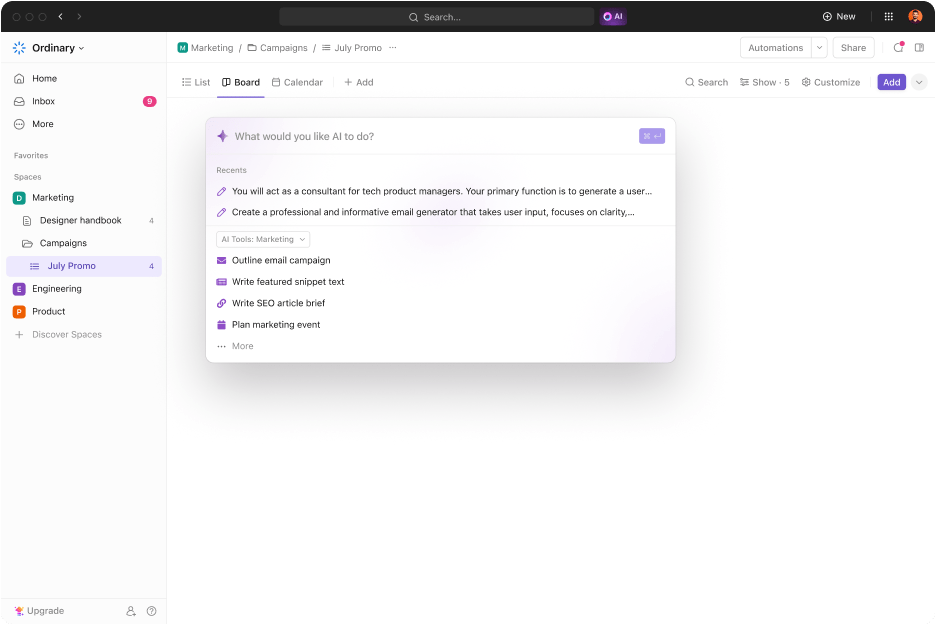
Consulting an AI might become your saving grace if you’re stuck on an idea. ClickUp AI helps you save time by enhancing productivity and enabling easy communication. It also effectively partners with your team’s quest to solve customer challenges and pain points.
ClickUp Whiteboard is an effective collaborative space for your team to jot down their ideas and share. Brainstorm, strategize, collaborate in real-time, add notes, and develop the best possible solutions in less time. It also enables you to add links, docs, and attachments so everyone is on the same page.
Gantt charts for visualizing
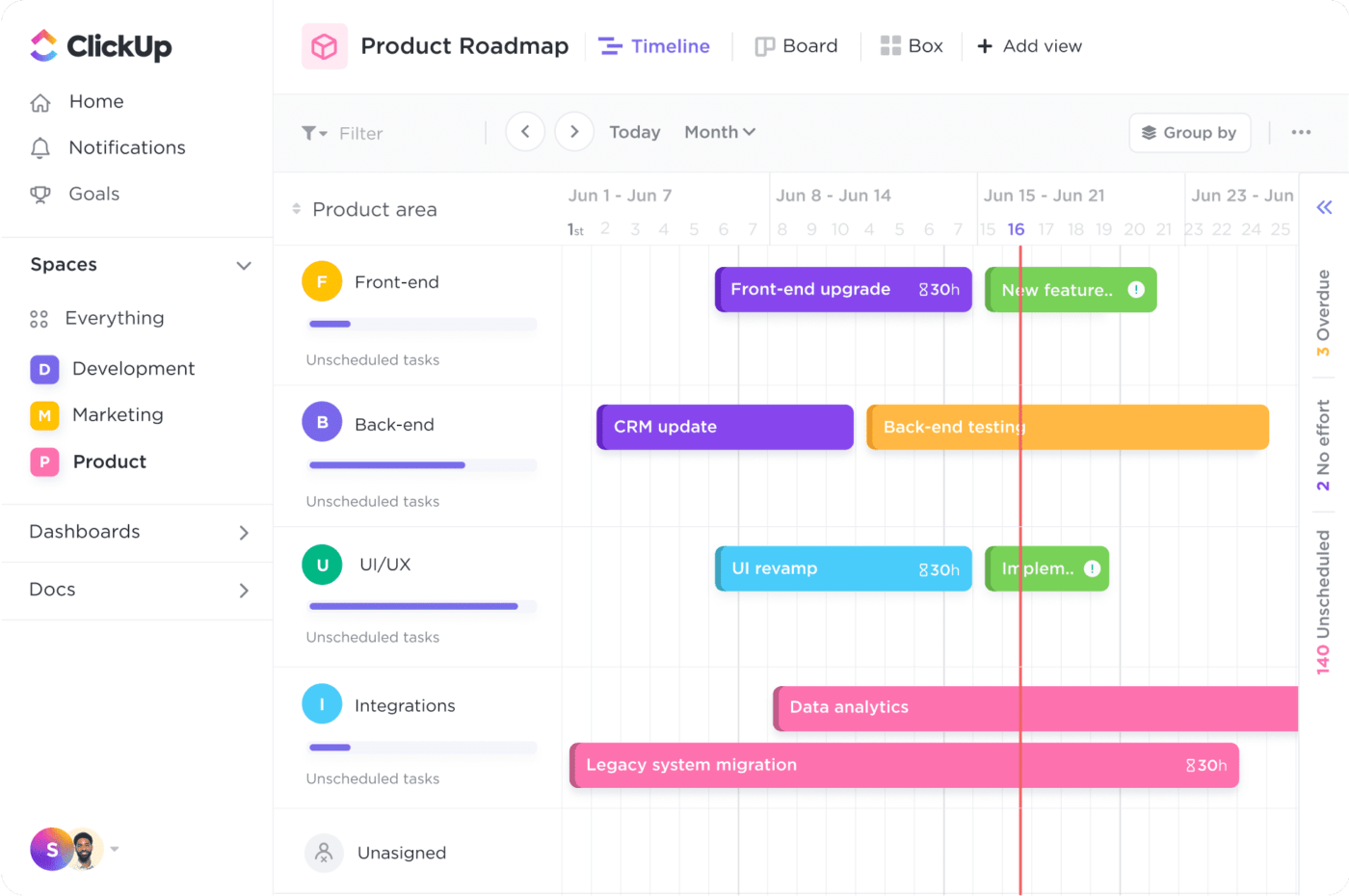
ClickUp Gantt charts help you visualize your product development timelines and share them across your team. Collaboration, tracking dependencies, and managing priorities are benefits of using Gantt charts. You can get a bird’s-eye view of all your products and stages.
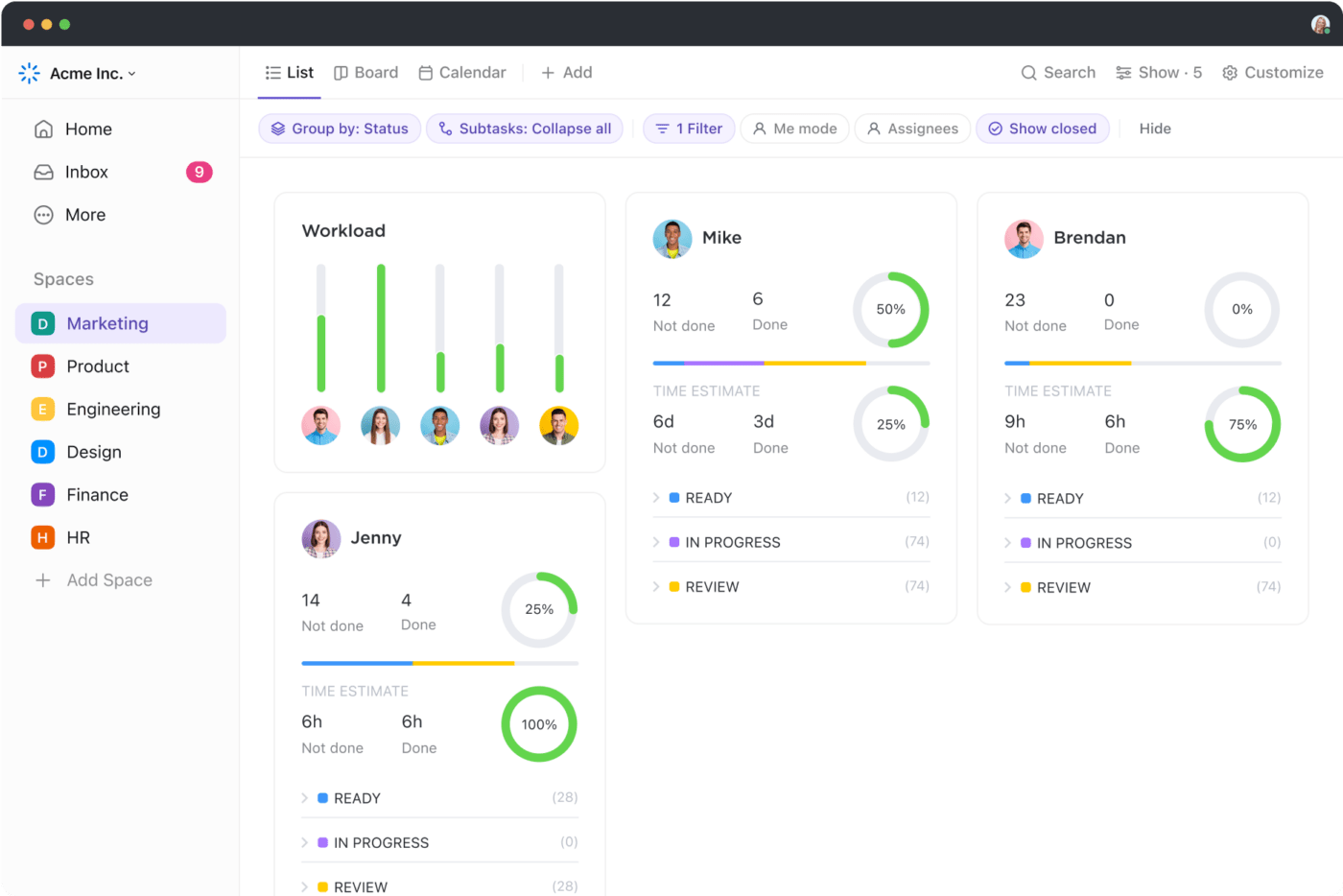
ClickUp offers several views that one can effectively use at different phases of product discovery. For example, you can use List View to organize and track various stages. Task view will give you an accurate look at the status of each task. Further, Team View lets you look at each team member’s progress.
Conclusion
A successful product discovery stage leads to developing a successful product that your users cherish. That is why it is crucial to take your time during this process.
By strongly emphasizing understanding user needs, leveraging cross-functional collaboration, and embracing an iterative approach, you can confidently navigate the complex world of product development.
Of course, tools like ClickUp have the potential to become your best ally during this process. Take a free trial today and check for yourself!
FAQs
What are the goals of product discovery in 2024?
The goals of product discovery include understanding users’ pain points and challenges and addressing them with innovative solutions.
What is the step-by-step process of product discovery?
Product discovery has five steps:
- Create a cross-functional team
- Understanding the underlying user needs
- Ideating
- Developing the prototype
- Testing the prototype
How can tools like ClickUp boost product discovery processes?
Tools like ClickUp enhance product discovery by providing a collaborative workspace, efficient product management, seamless document sharing, integration with other tools, communication channels, effective customer feedback management, and timeline tracking features.



